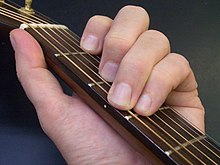Guitar grip

As a guitar chord is called a finger combination, with the chords are gripped on the guitar. With the fingers of the picking hand or pick it are strings plucked or struck.
Each chord can be played in many different positions on the fingerboard, with the shape of the fingering changing. These different possibilities are often shown in fingering charts (see below).
With some chords it is necessary to press down several (up to six) strings on a fret with the index finger of the gripping hand (shown as a bar in the fingering). Such attacks are known as Barre -Handles. They are often difficult for beginners because, among other things, they require a very precise placement of the fingers. However, it is easier to achieve if the required pressure of the thumb is supported by gently pulling the gripping hand backwards. The advantages of barre fingerings: With strumming rhythms, the damping of the strings is made easier and you can easily transpose chords .
Strings that are struck but not fingered are called open strings or open strings. There are also open tunings in which the six open strings without a fingering form a simple chord.
Fingering of some chords
| C. | D. | E. | F. | G | A. | H | |
|---|---|---|---|---|---|---|---|
|
Z or 1 = index finger |
|||||||
Web links
- Generator for fingerings and chord symbols, derivation and use of different chord types, chord progressions, quizzes (in German and English)
- Fingerings for all chords in different tunings on different stringed instruments
- Fretboards for all chords (also determines a chord for a given fretboard)
- All guitar chords at a glance
- Fingering patterns of basic and more specialized chords
- Fingering for all chords with names in German
Individual evidence
- ↑ Peter Autschbach: Rock On Wood. Akustikgitarrenschule, Acoustic Music Books, Wilhelmshaven 2011, ISBN 978-3869471006 , p. 72 ff.







































